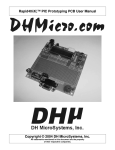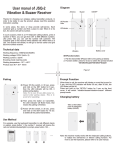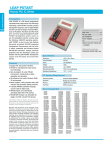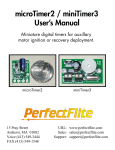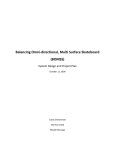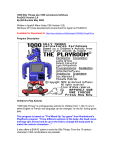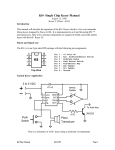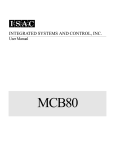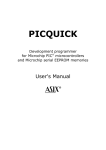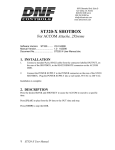Download Rapid18iXL™ PIC Prototyping PCB User Manual
Transcript
Rapid18iXL™ PIC Prototyping PCB User Manual Copyright © 2004 DH MicroSystems, Inc. All trademarks mentioned in this document are the property of their respective companies. Rapid18iXL™ PIC Prototyping PCB User Manual Description This is a PCB designed to facilitate the rapid prototyping of a device based on an 18 pin MicroChip PIC microcontroller. To allow users to focus on their application, we take care of key housekeeping tasks associated with a microcontroller-based device. To this end, our PCB features several power supply options, an 18 pin footprint for the microcontroller, and several oscillator options. This board also supports in-circuit programming with a dedicated ICSP header. Users can construct their application circuit in our generous a generous prototyping area with space available for several IC’s and/or numerous discrete components. Like our Rapid18i prototyping board, the Rapid18iXL board has common I/O components; it has the same 2 push buttons, 2 LEDs, and a buzzer. It also has a RS232 interface that can be jumper configured for DCE configuration for attachment to a PC, or as DTE for attachment to another prototyping board (no null modem cables required). See last page of this document for detailed serial interface information. This board is constructed as a 2-layer throughhole board with clearly marked components on its silkscreen layer, and ample space between components so population of the board can be done by anyone with basic soldering skills. Additional Resources Numerous sources of information are available for both beginning and advanced users. Microchip Technology Inc. manufactures the PIC microcontroller line. Their website can be found at www.microchip.com. It contains datasheets for all of their microcontrollers, app-notes, and code samples for a variety of applications. Another excellent on-line resource for Microchip PIC development is the Piclist at www.piclist.com. It contains project info, code examples, and links to PIC related sites. Beginner users might also consider the books published by Square 1 Electronics. They can be found at www.sq-1.com. This list is by no means comprehensive. Many other excellent websites and publications are available and this list is only intended as a starting point for the beginner. Features General: • • • • • • • Overall board dimensions 3.50” x 3.25”. PCB is a 2-layer board with solder masks on both sides and a silk screen graphic. 31 x 13 pin prototyping area (403 pins total). Power and GND bus lines run the length of the prototyping area on both sides All 13 microcontroller port pins and ~MCLR pin brought out to a clearly labeled strip along the top of the prototyping area. ICSP header. 4 corner mounting holes. Microprocessor: • • Compatible with all MicroChip PIC 18 pin DIP packaged microprocessors. PIC16C52, 54, 56, 58, 554, 556, 558, 61, 620, 621, 622, 71, 710, 711, 712, 715, 716, 717, 84, PIC16E623, 624, 625, PIC16F627, 628, 818, 819, 83, 84 (and others). Oscillator Options: • • • Crystal or ceramic resonator (DC-20MHz). Ceramic resonator with internal capacitors (DC20MHz). RC oscillator. Power Supply Options: • • • Footprints provided for either TO-92 or TO-220 voltage regulators. Footprint provided for DC power receptacle. Power-on LED. User I/O Options: • • • • 2 push buttons. 2 LEDs. Piezo buzzer. RS232 interface. Requirements In order to assemble and use this board, a user needs to have basic electronic tools and some skill in their usage, and an 18 pin PIC microcontroller and the tools required to write code and program the executable file onto the controller. Additionally, if this board was purchased as a bare PCB, then a number of discrete components are also required to stock it appropriately for use. Copyright © 2004 DH MicroSystems, Inc. All trademarks mentioned in this document are the property of their respective companies. Rapid18iXL™ PIC Prototyping PCB User Manual Board Schematic Construction Partlist: If you purchased this as a kit, then it included the following components: • Printed circuit board • IC1-18 pin socket • X1-4MHz ceramic resonator • VREG1-78L05 voltage regulator (TO-92) • DC power receptacle • JU2-ICSP header • JU3-Jumper block with shorting jumper • C1-47uF electrolytic capacitor • C2, C4, C5, and C8-0.1uF capacitors • R1-470 Ohm, 1/8W, resistor • R3-10k Ohm, 1/8W, resistor • D1-Green LED • D2-1N4148 diode If purchased as a kit including parts to complete the user I/O circuitry then it also included: • SW1 and SW2-tactile push-button switches • LED1 and LED2-red and yellow LEDs • BUZZ-5V piezo buzzer • Q1-2N2222 (TO-92) NPN transistor • R4, R7, and R8-10k Ohm, 1/8W, resistors • R5 and R6-470 Ohm, 1/8W, resistors If purchased as a kit including parts to complete the RS232 interface then it also includes: • IC2-232 driver IC and 16 pin socket • DB9F connector • JU1-2x5 pin header & 4 shorting jumpers • C9 to C13-0.1uF capacitors • C14-47uF electrolytic capacitor Copyright © 2004 DH MicroSystems, Inc. All trademarks mentioned in this document are the property of their respective companies. Rapid18iXL™ PIC Prototyping PCB User Manual Construction (Cont.) Microcontroller Options: This board will support any 18 pin DIP packaged Microchip PIC microcontroller. The pin descriptions depicted in the schematic on the previous page and on our PCBs represent only basic port definitions for each pin. Refer to the Microchip datasheet for all the features and alternate pin definitions for the microcontroller that you select for use. R3, C8, and D2 are attached to the ~MCLR pin (D2 is added for ICSP compatibility). These components can be omitted and a new reset circuit can be constructed in the prototyping area per instructions found in the Microchip datasheet for your microcontroller. ICSP: Note: refer to Microchip datasheets and appnotes for information on the isolation of ICSP related pins. ICSP signals are available on JU2 (refer to the schematic for pin signal assignments). Depending on what PIC is selected for use the PGM pin may be RB3 or RB4; to configure for either short either (not both) position 3 or 4 on the jumper labeled PGM with a short length of component lead left over from the construction of this board. Refer to the Microchip datasheet for the PIC you select for the assignment of the PGM pin. JU3 isolates the PIC from the boards power supply; it should be disconnected when the prototyping board is attached to an ICSP programmer. This jumper eliminates the possibility of excessive loading of the ICSP programmer by other board components or by the users application circuitry. Re-jumper JU3 when the ICSP programmer is disconnected and the board is to be powered via the onboard power supply. If you are not planning on using an ICSP programmer JU2 can be omitted, JU3 can just be permanently shorted with a bit of component lead, and D2 can be replaced with another bit of component lead. Oscillator Options: Several oscillator options are available with this board: ceramic resonator, crystal oscillator, and RC oscillator (kits ship with a 4MHZ ceramic resonator). Pertinent oscillator parts are R2, C6, C7, and X1. Select these components per instructions found in Microchip datasheets for the microcontroller that you select for use. Power Supply Options: This board will support several different voltage regulators in both TO-92 and TO-220 packages (kits ship with a TO-92 78L05) Note: install only one voltage regulator when assembling your board. Keep in mind the current requirements of your circuitry plus the microcontroller when you are selecting an appropriate voltage regulator. Depending on the requirements for the regulator you select, C1, C2, C3, and C4 may or may not be required and their values will vary. Refer to the manufacturers datasheet for your regulator you select for recommendations. A wall adapter can provide power when the DC power receptacle is installed. A 2.1mm ID, 5MM OD DC power plug with a positive center conductor is required. A bench supply can also be used; in this case omit the power receptacle and solder in red and black wires to the pins labeled Vin and GND respectively. Voltage should be 7.5-12VDC. A power-on LED may be installed by stocking R1 and D1 (a green LED). 232 Interface Options: This board offers a jumper-configurable 232 interface to allow the user to connect it to a PC or to another similarly equipped prototyping board. Details regarding configuring this board as DTE or DCE can be found on the next page. Assembly: Stock parts in their appropriate locations, paying attention to proper component alignment. Solder components to the PCB with a low wattage soldering iron. Lastly, trim off excess leads and clean off flux residue (if required) with an appropriate solvent. Construct your own circuitry in the open prototyping area. Microcontroller pins and I/O components are accessed through the labeled strip of pins at the top of the proto area. 5V and GND for your circuit is available on both left and right sides of the proto area in labeled strips. Note: parts are not provided to fill all PCB component footprints. The user should stock the board appropriately according to the requirements of any particular design. Copyright © 2004 DH MicroSystems, Inc. All trademarks mentioned in this document are the property of their respective companies. Rapid18iXL™ PIC Prototyping PCB User Manual 232 Serial Interface Configuration 232 Interface Notes: Note: the arrows in the above figure denote the signal direction between the processor and the DB9 connector. For example, the arrow on the TxD line shows it going to the DB9F connector from the processor; the arrow on the RxD line shows it going to the processor from the DB9F connector. JU1 Jumper Settings: DTE: Setting the JU1 jumpers as shown in the left figure above setups the DB9 in a DTE configuration. This configuration can be used to connect to another prototyping board configured as DCE. Note: while this configuration is labeled DTE, obviously the gender of the DB9 connector is not male. However, if one attaches a DB9M to DB9M straight-through wired serial cable to the DB9Fconnector on the PCB, then the signals and gender on the opposite end of the serial cable is appropriate for DTE and can be plugged directly into a DCE configured board. DCE: Setting the JU1 jumpers as shown in the center figure above setups the DB9 in a DCE configuration. This configuration can be used to connect to a PC serial port or another prototyping board configured as DTE. To connect to a PC use a straight-through wired DB9M to DB9F serial cable. Both of the first examples have active RTS & CTS signals for half-duplex operation. The last figure above is DCE which is fully handshake looped (RTS and CTS lines are now shorted together). This configuration can be used for full-duplex serial communication with a PC; a similar arrangement can be used in the first DTE configuration. Contact Us We maintain a website where you can get information on our products, obtain literature, and download support files. Visit us online at: www.dhmicro.com Email your technical support questions to [email protected]. We try to respond to your questions within an hour if it is received Monday through Friday between the hours of 8am to 5pm (Mountain Time). For sales questions or to place an order, direct your emails to [email protected]. Refer to the order form and price list available on our website for product pricing, shipping rates, payment instructions, and for other info we need to complete your order. Our mailing address: DH MicroSystems, Inc. P.O. Box 2272 Pocatello, ID 83206-2272 Disclaimer: DH MicroSystems, Inc. reserves the right to modify its products or literature, or to discontinue any product at any time without prior notice. The customer is responsible for determining the suitability of any device for any application developed using DH MicroSystems, Inc. components. Copyright © 2004 DH MicroSystems, Inc. All trademarks mentioned in this document are the property of their respective companies.





